December 16, 2001
MONO CLIFFS - 2nd Line entrance (West
side)
Meeting report by Nathan and Alexis Burnett
(Photos by Walter Muma)
|
|
|
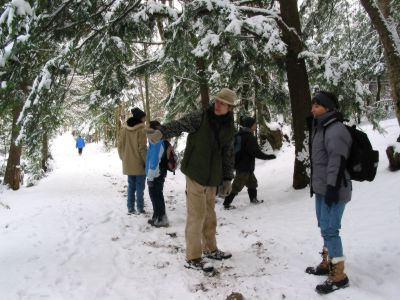 |
Well, our first outing to the Mono Cliffs went
off without a hitch. We had a great turnout of approx. 30 people.
After some short introductions we headed out in search of adventure surrounded
by the beauty of the hardwood forest. |
|
| |
| Not far down the trail Walter and Julie showed us
all one of the great uses of tinder fungus that grows on the birch trees.
These funguses are great for keeping a burning coal, what a treat! |
|
|
| |
| We
spent a short time here looking at the differences between the birch, beech,
maple and hemlock trees and briefly talked about some of their many uses.
We were lucky to have some Sir Sanford Fleming students with us that had just
finished their winter tree I.D. class. They proved to be a valuable asset
to our hike. |
|
|
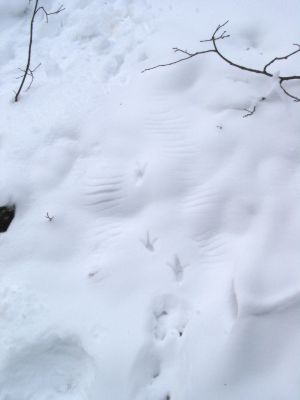 |
After a short stop around the lookout platform
and the Crevasse, we trekked on downhill toward the pond and Bruce Trail.
Someone spotted some beautiful ruffed grouse tracks and wing impressions in the
snow! Little did we know that the grouse was up in the cedar tree no more
than 20 ft. away! It exploded out of the tree in a flutter of wing beats as
someone followed the tracks closer to that point. The snow and winter
conditions were a blessing on this day. |
|
| |
| We moved across the landscape in a 'slinky-like'
fashion. One group moving ahead and then slowing as the other group caught
up. Between all the participants there was a wealth of information that
was shared. We stopped and identified trees and their uses, tracks and the
animals that made them and a bird nest or two or three were also spotted, among
many other discoveries. We moved through different habitats noticing the
subtle and not so subtle differences between them. |
|
|
|
|
| |
| A red-tail hawk was spotted soaring over the
meadow -- perhaps hunting for rodents on the snow-covered ground? Here on
the edge of the meadow we noticed some white and yellow birch trees. You could
see the bark on different trees all in different stages of growth. Young -
purple, turning white and then full white. There was also evidence of
porcupines feeding on hawthorns and maple bark. In the
hawthorn/apple tree meadow we also noticed some staghorn sumac trees and perhaps
a northern shrike nest in the hawthorns as well. |
| |
|
|
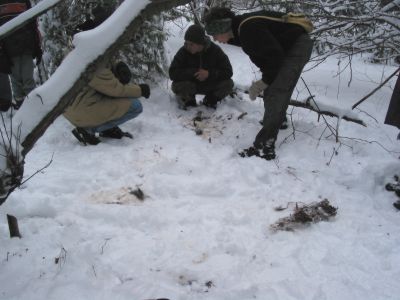 |
As we neared the beaver dam area we began to see
red fox tracks crossing the trail and urine markings in the snow. Not far
away we discovered a 'kill-site' right next to the beaver pond. What a
find! There were wild canine tracks coming and going and what looked and
smelled like fox scat surrounding the site. With some investigating we
determined that the kill was a porcupine and began to speculate and try to piece
the story back together. It had all happened within the past two days and
some of the bones had been chewed and there was not much left of the carcass.
We asked many questions and searched for possible conclusions as to what had
happened here. Did the porcupine die naturally and then get scavenged
upon? Was it attacked? How many animals had fed upon it? The
questions were endless. It was a great find, as many people in our group
had never witnessed a scene quite like this before. |
|
| |
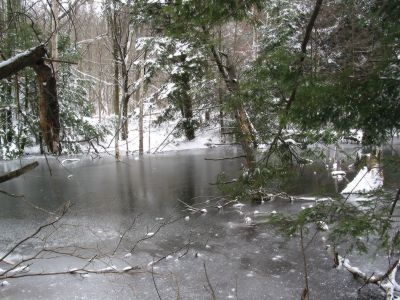 |
Some people explored the beaver pond area, while
others were still captivated by 'the kill'. The beavers had a huge
food-cache for the winter (cut trees and branches in the pond) that will serve
them well during the colder months. |
|
| |
| The area surrounding the pond showed a
great amount of 'pruning' done by the beavers and the water level was quite high
as well. |
|
|
| |
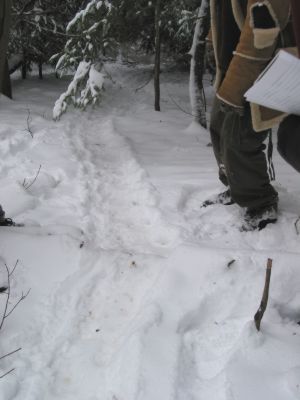 |
There were even some fresh beaver tracks found in the snow. Around the beaver lodge there were trails and
slides everywhere. What a sweet spot! The slides In the snow
indicated graceful playtime by the Castor Canadensis. |
|
| |
| Nearby on a fallen
log lay some red squirrel tracks. We talked briefly about some tracking
fundamentals as we discovered many tracks throughout the day including deer, red
fox, squirrels, weasels, porcupine, grouse etc. While proceeding up the
trail in a group, few noticed Nathan high up in a pine tree, however some did
notice him as by that time we were spending a lot of time looking at all the
trees. |
|
|
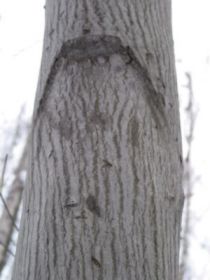 |
Serviceberry
tree.
(Some of the group were trying to identify this). |
|
| |
It was great to have so many people together as
we all inspired each other with the knowledge and questions, which we all
shared. By the end of the day there was nothing that we could walk past
that seemed uninteresting and many people held back to 'squeeze' in some more
discoveries of the natural
world. A great time was had by all and we look forward to seeing everyone
out on our upcoming hikes. |
|
|
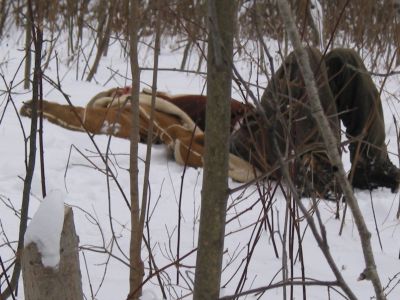 |
A big THANK-YOU goes out to all those who showed up
for our first hike!
HAPPY HOLIDAYS!
|
|
| |
| For more Tree ID information, visit the
Ontario Trees & Shrubs website |
| |
| |